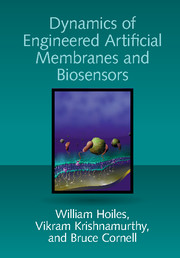Book contents
- Frontmatter
- Contents
- Preface
- List of Abbreviations
- Part I Introduction and Background
- 1 Motivation and Outline
- 2 Biochemistry for Engineers: A Short Primer
- 3 Engineered Artificial Membranes
- Part II Building Engineered Membranes, Devices, and Experimental Results
- Part III Dynamic Models for Artificial Membranes: From Atoms to Device
- Appendices
- Bibliography
- Index
2 - Biochemistry for Engineers: A Short Primer
from Part I - Introduction and Background
Published online by Cambridge University Press: 25 May 2018
- Frontmatter
- Contents
- Preface
- List of Abbreviations
- Part I Introduction and Background
- 1 Motivation and Outline
- 2 Biochemistry for Engineers: A Short Primer
- 3 Engineered Artificial Membranes
- Part II Building Engineered Membranes, Devices, and Experimental Results
- Part III Dynamic Models for Artificial Membranes: From Atoms to Device
- Appendices
- Bibliography
- Index
Summary
Biochemistry deals with chemical processes occurring in living organisms. An elementary understanding of the biochemistry of cell membranes is important for understanding the key ideas behind engineered artificial membranes and biosensing. This chapter gives a brief description of the key chemical components in cell membranes, namely, lipids, proteins, and peptides. Lipids are the primary component of all cell membranes; and peptides and proteins are the primary component of signaling in living organisms. Additionally, we discuss tethers and spacers, which provide the basis for connecting engineered membranes to a bioelectronic interface; this bioelectronic interface is connected to electrical measurement equipment that allow signals to be acquired from the device.
With the availability of powerful computer-based visualization tools (discussed at the end of this chapter), it is strongly recommended that the reader use these tools to get a better feel for the various types of biochemical molecules described in this chapter. These software tools are also a first step in more sophisticated molecular dynamics simulations that are discussed in Part III of the book.
Bonded and Nonbonded Molecular Interactions
A chemical bond is an attraction between two or more atoms that facilitates the formation of multiatom chemical compounds. There are two main types of chemical bonds: ionic bonds and covalent bonds. In addition there are also van der Waals forces, a type of nonbonded interaction between atoms, which include attraction or repulsion between atoms that do not arise from covalent or ionic bonds. Specifically, van der Waals forces are a consequence of quantum dynamics in which repulsive or attractive forces between atoms result from correlations in the fluctuating polarizations of atoms. In this section we define the covalent and ionic bonds as well as the van der Waals interaction between atoms and their importance in the dynamics of cell membranes. Additionally, we describe their importance when constructing molecular dynamics simulations.
Covalent bond. A covalent bond is a chemical bond formed by sharing electrons between atoms. Covalent bonds are key to the structure of nearly all chemical compounds such as water, lipids, peptides, and proteins. The covalent bond is one of the strongest bonds compared with ionic bonds and van der Waals interactions. Typically the covalent bond has a bond energy in the range of 120 to 1000 kJ/mol (120– 500 kJ/mol for single bonds, and up to 1000 kJ/mol for triple bonds).
- Type
- Chapter
- Information
- Publisher: Cambridge University PressPrint publication year: 2018



